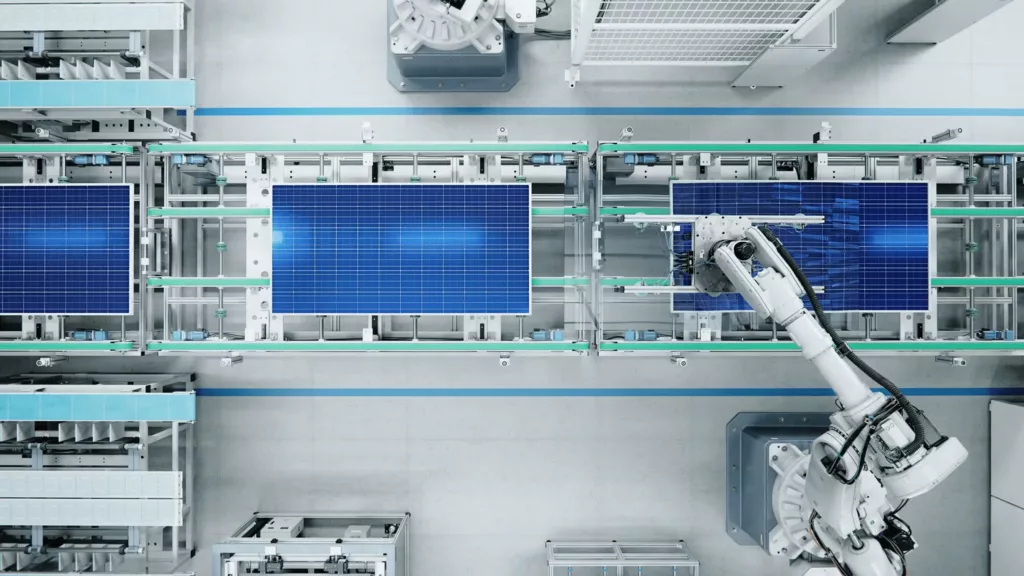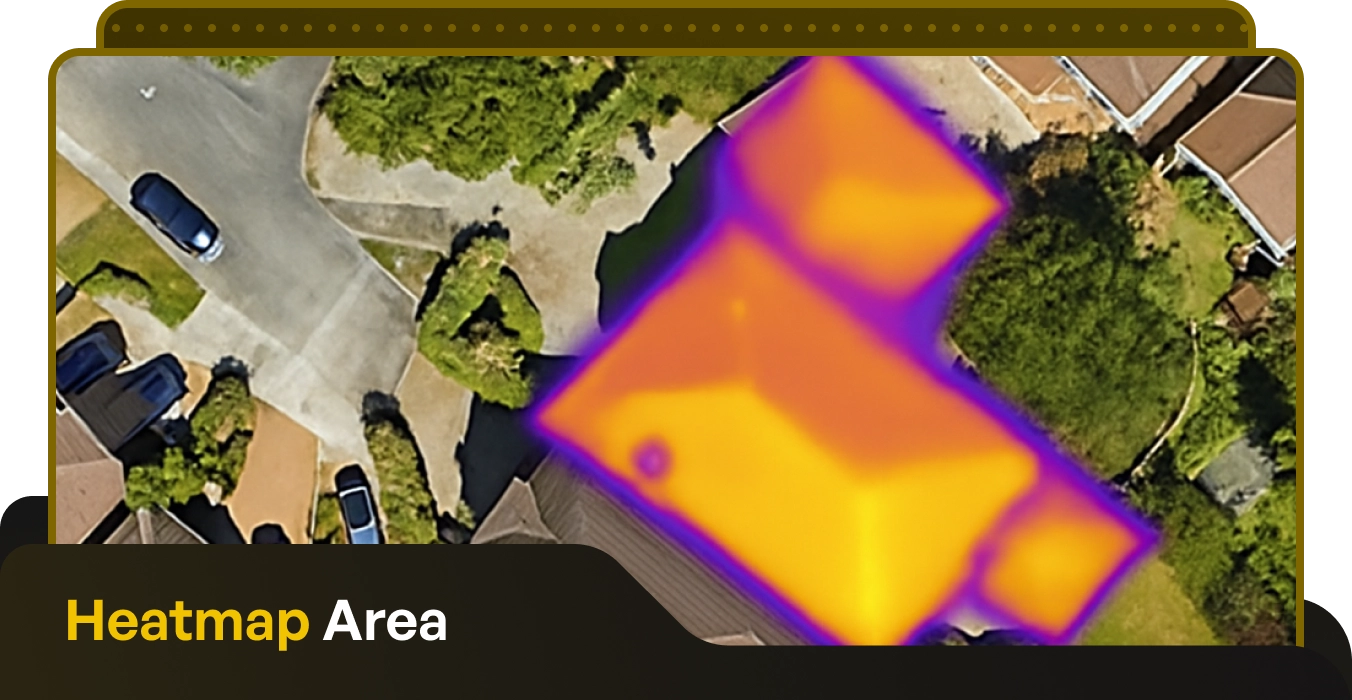Table of Contents
Understanding Solar Panel Efficiency

Written by: Briain Kelly
Published: September 2, 2025
Last updated: October 8, 2025
Reading time: 4 mins
The efficiency of a solar panel is one of the most important factors to understand, since it plays a huge role in determining its performance.
When purchasing solar panels, the one with the greater efficiency might cost more, but will also generate more electricity in the same conditions than one with a lower efficiency.
But why is this, and what determines the efficiency of a solar panel? In this guide, we dive into the basics of what the efficiency of a solar panel is, and why some are more efficient than others.
What is solar panel efficiency?
Solar panels are not perfect at converting light into electricity, far from it. The amount of light which is converted into electricity is referred to as the efficiency of the solar panel or cell, which is expressed as a percentage.
Good residential solar panels typically have an efficiency of roughly 22% – 24%, though this can vary based on the type of material they’re made from and their environmental conditions.
What affects the efficiency of solar panels?
There are many things, big and small, that go into affecting the efficiency of solar panels. This is true of the efficiency given by the manufacturer’s datasheet, and in their real world operating conditions.
The chief factors governing solar panel efficiency are:
Solar Cell Material: Whether your panels are made from monocrystalline, polycrystalline, or thin-film solar cells.
Solar Cell Manufacturing: There are many different types of ways in which solar cells can be produced, beyond just their base material.
The Most Efficient Types of Solar Panels
There are three main types of materials that solar panels can be made from currently, which have differing levels of efficiency.
Monocrystalline: Each solar cell is made from a single silicon crystal. The most efficient type of solar cell on the mass market currently, these typically have an efficiency of 21.5% – 24%.
Polycrystalline: Solar cells are made from multiple silicon crystals melted together. Becoming much less common as mono panels take over, polycrystalline panels typically have an efficiency of 16% – 20%.
Thin Film: Made from several layers of photovoltaic material laid over a substrate, these can have an efficiency of 7% – 13%.
How efficient solar panels within any of those categories will depend on the quality of their manufacturing and the methods used.
Solar Cell Manufacturing Techniques
There are many different ways in which solar cells can be made and solar panels assembled, which will affect their final efficiency.
P-type & N-type: Older solar panels mostly use P-type solar cells, but the more efficient N-type cells have taken over most of the market.
Half-Cut Cells: Half-cut solar cells lose less energy to electricity resistance and shading due to their smaller size and the wiring of the panels.
Back Contact Panels: Solar panels which place the electrical contacts on the rear of the panel, rather than the front, eliminate the distinctive metal grid lines that reduce the amount of sunlight the panels can receive.
HJT Solar Cells: Combine the traditional silicon layer with two thin-film amorphous silicon layers to improve efficiency.
TOPCon Solar Cells: A Tunnel Oxide Passivated Contact layer on the rear of the solar cells improves efficiency in low light conditions.

Solar Panel Efficiency at High Temperatures
Solar panels don’t actually like high temperatures; they work off light, not heat. The hotter the internal temperature of the panel becomes, the less efficient it becomes.
The Standard Test Conditions for solar panels in the lab measure their efficiency at a cell temperature of 25 degrees Celsius. When the panel temperature rises above that level, they begin to lose efficiency.
Because the real world rarely mimics lab conditions, most solar panels specifications will include how much power they will produce under a Nominal Operating Cell Temperature (NOCT), usually around 44 degrees.
Power Temperature Coefficient
The amount by which electricity generation decreases as the cell temperature rises above or below 25 degrees Celsius is known as the power temperature coefficient.
The temperature coefficient is measured as a % / ℃, with the value always a negative percentage. The lower the temperature coefficient is, the more efficient the panel is at dealing with higher temperatures.
For instance, if you see a solar panel with a Temperature Coefficient of Pmax of -0.4%, that means the solar panel will lose 0.4% of its power for every degree over 25 that it goes.
High-end monocrystalline N-Type solar cell panels have a temperature coefficient of -0.25% to -0.29%.
Solar Cell Efficiency vs Solar Module Efficiency
There are two different scenarios where you will see efficiency mentioned in solar PV technology. The first is the conversion efficiency of a solar cell, and the second is the efficiency of a solar module.
It is common to see cell efficiency ratings which are considerably higher than the overall module efficiency.
This is because once solar cells are assembled together into panels, other elements such as the frame and glass can lower that efficiency level as they will absorb or reflect light also.
When you are looking at solar panels, the panel efficiency or module efficiency is the figure which concerns you, since it tells you how they will actually perform on your home.
Combined Efficiency of a Solar PV System
Your solar panels aren’t the only part of the system that delivers electricity to your house. All solar PV systems include an inverter, and many homes are also now installing battery storage systems.
Both of these have their own efficiency levels, which will affect the final figure for how much juice you get from your solar panels.
The solar power inverter is what converts the DC electricity produced by your solar PV array into AC electricity, which is usable in your household.
Your solar panels might be connected on a string to a single inverter, or in some cases might have microinverters connected to each panel.
A good solar inverter should have an efficiency level of 96% – 98.5%, with the remainder of the power lost in the conversion.
Will solar panels become more efficient in the future?
Solar panels are becoming more efficient all the time as manufacturers continue to invest in researching new technologies that can bring that can increase their efficiency.
Pure silicon solar panels, which currently dominate the market, have a theoretical limit to their efficiency of 33.7%. However, in real world conditions and limitations, this is likely to be closer to 29% for silicon solar panels.
However, solar panels can be assembled differently in ways which would allow them to exceed this. The next big generational leap in solar technology will be the introduction of silicon-perovskite tandem solar cells.
These tandem solar cells will combine a silicon cell with a perovskite cell, each of them optimised to absorb different wavelengths of light. This allows them to get more from light together than either of them could alone.
Understanding Solar Panel Efficiency
Published: September 2, 2025
Last updated: October 8, 2025

Written by: Briain Kelly
Reading time: 4mins
The efficiency of a solar panel is one of the most important factors to understand, since it plays a huge role in determining its performance.
When purchasing solar panels, the one with the greater efficiency might cost more, but will also generate more electricity in the same conditions than one with a lower efficiency.
But why is this, and what determines the efficiency of a solar panel? In this guide, we dive into the basics of what the efficiency of a solar panel is, and why some are more efficient than others.
What is solar panel efficiency?
Solar panels are not perfect at converting light into electricity, far from it. The amount of light which is converted into electricity is referred to as the efficiency of the solar panel or cell, which is expressed as a percentage.
Good residential solar panels typically have an efficiency of roughly 22% – 24%, though this can vary based on the type of material they’re made from and their environmental conditions.
What affects the efficiency of solar panels?
There are many things, big and small, that go into affecting the efficiency of solar panels. This is true of the efficiency given by the manufacturer’s datasheet, and in their real world operating conditions.
The chief factors governing solar panel efficiency are:
Solar Cell Material: Whether your panels are made from monocrystalline, polycrystalline, or thin-film solar cells.
Solar Cell Manufacturing: There are many different types of ways in which solar cells can be produced, beyond just their base material.
The Most Efficient Types of Solar Panels
There are three main types of materials that solar panels can be made from currently, which have differing levels of efficiency.
Monocrystalline: Each solar cell is made from a single silicon crystal. The most efficient type of solar cell on the mass market currently, these typically have an efficiency of 21.5% – 24%.
Polycrystalline: Solar cells are made from multiple silicon crystals melted together. Becoming much less common as mono panels take over, polycrystalline panels typically have an efficiency of 16% – 20%.
Thin Film: Made from several layers of photovoltaic material laid over a substrate, these can have an efficiency of 7% – 13%.
How efficient solar panels within any of those categories will depend on the quality of their manufacturing and the methods used.
Solar Cell Manufacturing Techniques
There are many different ways in which solar cells can be made and solar panels assembled, which will affect their final efficiency.
P-type & N-type: Older solar panels mostly use P-type solar cells, but the more efficient N-type cells have taken over most of the market.
Half-Cut Cells: Half-cut solar cells lose less energy to electricity resistance and shading due to their smaller size and the wiring of the panels.
Back Contact Panels: Solar panels which place the electrical contacts on the rear of the panel, rather than the front, eliminate the distinctive metal grid lines that reduce the amount of sunlight the panels can receive.
HJT Solar Cells: Combine the traditional silicon layer with two thin-film amorphous silicon layers to improve efficiency.
TOPCon Solar Cells: A Tunnel Oxide Passivated Contact layer on the rear of the solar cells improves efficiency in low light conditions.

Solar Panel Efficiency at High Temperatures
Solar panels don’t actually like high temperatures; they work off light, not heat. The hotter the internal temperature of the panel becomes, the less efficient it becomes.
The Standard Test Conditions for solar panels in the lab measure their efficiency at a cell temperature of 25 degrees Celsius. When the panel temperature rises above that level, they begin to lose efficiency.
Because the real world rarely mimics lab conditions, most solar panels specifications will include how much power they will produce under a Nominal Operating Cell Temperature (NOCT), usually around 44 degrees.
Power Temperature Coefficient
The amount by which electricity generation decreases as the cell temperature rises above or below 25 degrees Celsius is known as the power temperature coefficient.
The temperature coefficient is measured as a % / ℃, with the value always a negative percentage. The lower the temperature coefficient is, the more efficient the panel is at dealing with higher temperatures.
For instance, if you see a solar panel with a Temperature Coefficient of Pmax of -0.4%, that means the solar panel will lose 0.4% of its power for every degree over 25 that it goes.
High-end monocrystalline N-Type solar cell panels have a temperature coefficient of -0.25% to -0.29%.
Solar Cell Efficiency vs Solar Module Efficiency
There are two different scenarios where you will see efficiency mentioned in solar PV technology. The first is the conversion efficiency of a solar cell, and the second is the efficiency of a solar module.
It is common to see cell efficiency ratings which are considerably higher than the overall module efficiency.
This is because once solar cells are assembled together into panels, other elements such as the frame and glass can lower that efficiency level as they will absorb or reflect light also.
When you are looking at solar panels, the panel efficiency or module efficiency is the figure which concerns you, since it tells you how they will actually perform on your home.
Combined Efficiency of a Solar PV System
Your solar panels aren’t the only part of the system that delivers electricity to your house. All solar PV systems include an inverter, and many homes are also now installing battery storage systems.
Both of these have their own efficiency levels, which will affect the final figure for how much juice you get from your solar panels.
The solar power inverter is what converts the DC electricity produced by your solar PV array into AC electricity, which is usable in your household.
Your solar panels might be connected on a string to a single inverter, or in some cases might have microinverters connected to each panel.
A good solar inverter should have an efficiency level of 96% – 98.5%, with the remainder of the power lost in the conversion.
Will solar panels become more efficient in the future?
Solar panels are becoming more efficient all the time as manufacturers continue to invest in researching new technologies that can bring that can increase their efficiency.
Pure silicon solar panels, which currently dominate the market, have a theoretical limit to their efficiency of 33.7%. However, in real world conditions and limitations, this is likely to be closer to 29% for silicon solar panels.
However, solar panels can be assembled differently in ways which would allow them to exceed this. The next big generational leap in solar technology will be the introduction of silicon-perovskite tandem solar cells.
These tandem solar cells will combine a silicon cell with a perovskite cell, each of them optimised to absorb different wavelengths of light. This allows them to get more from light together than either of them could alone.
Solar Energy Saves Households Thousands in Electricity Costs
Take our 2-minute questionnaire and find affordable solar options to suit your budget and lifestyle.



